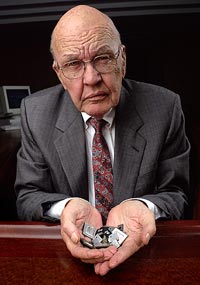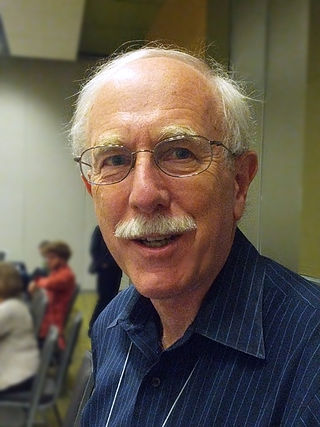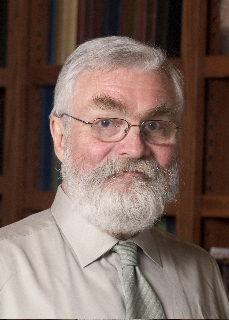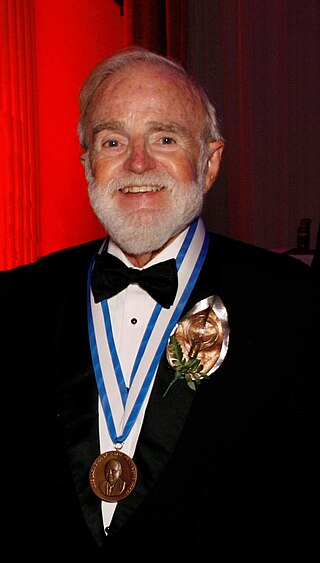Related Research Articles

Jack St. Clair Kilby was an American electrical engineer who took part, along with Robert Noyce of Fairchild Semiconductor, in the realization of the first integrated circuit while working at Texas Instruments (TI) in 1958. He was awarded the Nobel Prize in Physics on 10 December 2000.
Lawrence R. Rabiner is an electrical engineer working in the fields of digital signal processing and speech processing; in particular in digital signal processing for automatic speech recognition. He has worked on systems for AT&T Corporation for speech recognition.
Ronald W. Schafer is an American electrical engineer notable for his contributions to digital signal processing.

Jack Joseph Dongarra is an American computer scientist and mathematician. He is the American University Distinguished Professor of Computer Science in the Electrical Engineering and Computer Science Department at the University of Tennessee. He holds the position of a Distinguished Research Staff member in the Computer Science and Mathematics Division at Oak Ridge National Laboratory, Turing Fellowship in the School of Mathematics at the University of Manchester, and is an adjunct professor and teacher in the Computer Science Department at Rice University. He served as a faculty fellow at the Texas A&M University Institute for Advanced Study (2014–2018). Dongarra is the founding director of the Innovative Computing Laboratory at the University of Tennessee. He was the recipient of the Turing Award in 2021.
James William Cooley was an American mathematician. Cooley received a B.A. degree in 1949 from Manhattan College, Bronx, NY, an M.A. degree in 1951 from Columbia University, New York, NY, and a Ph.D. degree in 1961 in applied mathematics from Columbia University. He was a programmer on John von Neumann's computer at the Institute for Advanced Study, Princeton, NJ, from 1953 to 1956, where he notably programmed the Blackman–Tukey transformation.
Thomas Kailath is an Indian born American electrical engineer, information theorist, control engineer, entrepreneur and the Hitachi America Professor of Engineering emeritus at Stanford University. Professor Kailath has authored several books, including the well-known book Linear Systems, which ranks as one of the most referenced books in the field of linear systems.

Thomas Greenway Stockham was an American scientist who developed one of the first practical digital audio recording systems, and pioneered techniques for digital audio recording and processing. He also led the development of the Digital Audio Tape (DAT) system.

James H. McClellan is the Byers Professor of Signal Processing at the Georgia Institute of Technology. He is widely known for his creation of the McClellan transform and for his co-authorship of the Parks–McClellan filter design algorithm.

Thomas Shi-Tao Huang was a Chinese-born American computer scientist, electrical engineer, and writer. He was a researcher and professor emeritus at the University of Illinois at Urbana-Champaign (UIUC). Huang was one of the leading figures in computer vision, pattern recognition and human computer interaction.
Alan Victor Oppenheim is a professor of engineering at MIT's Department of Electrical Engineering and Computer Science. He is also a principal investigator in MIT's Research Laboratory of Electronics (RLE), at the Digital Signal Processing Group.
Arun N. Netravali is an Indian–American computer engineer credited with contributions in digital technology including HDTV. He conducted research in digital compression, signal processing and other fields. Netravali was the ninth President of Bell Laboratories and has served as Lucent's Chief Technology Officer and Chief Network Architect. He received his undergraduate degree from IIT Bombay, India, and an M.S. and a Ph.D. from Rice University in Houston, Texas, all in electrical engineering. Several global universities, including the Ecole Polytechnique Federale in Lausanne, Switzerland, have honored him with honorary doctorates.
Fumitada Itakura is a Japanese scientist. He did pioneering work in statistical signal processing, and its application to speech analysis, synthesis and coding, including the development of the linear predictive coding (LPC) and line spectral pairs (LSP) methods.

Robert M. Gray is an American information theorist, and the Alcatel-Lucent Professor of Electrical Engineering at Stanford University in Palo Alto, California. He is best known for his contributions to quantization and compression, particularly the development of vector quantization.
The IEEE Jack S. Kilby Signal Processing Medal is presented "for outstanding achievements in signal processing" theory, technology or commerce. The recipients of this award will receive a gold medal, together with a replica in bronze, a certificate and an honorarium.

Richard G. Baraniuk is the C. Sidney Burrus Professor of Electrical and Computer Engineering at Rice University and the Founder and Director of the open education initiative OpenStax.
Thomas W. Parks was an American electrical engineer and Professor Emeritus of Electrical and Computer Engineering at Cornell University. He is best known for his contributions to digital signal processing, especially digital filter design and computation of the fast Fourier transform. His last work before retirement was in the area of demosaicing.

Harry Leslie Van Trees was an American scientist specializing in radar, sonar, communications and signal processing.
Minerva Yeung is an American research scientist and educator best known for her work in video processing, multimedia information systems, and digital watermarking.
Ramalingam "Rama" Chellappa is a Bloomberg Distinguished Professor, who works at Johns Hopkins University. At Johns Hopkins University, he is a member of the Center for Language and Speech Processing, the Center for Imaging Science, the Institute for Assured Autonomy, and the Mathematical Institute for Data Sciences. He joined Johns Hopkins University after 29 years at The University of Maryland. Before that, he was an assistant, associate professor, and later, director, of the University of Southern California's Signal and Image Processing institute.
References
- ↑ "Sidney Burrus, former dean and pioneer in digital signal processing, dies at 86". Rice University. Retrieved 4 September 2021.
- ↑ Nebeker, Frederik (26 January 2021). "C. Sidney Burrus, an oral history conducted in 1998". IEEE History Center.
- ↑ C.S. Burrus's Rice Biography
- ↑ Publications from Google Scholar
- ↑ "IEEE Jack S. Kilby Signal Processing Medal Recipients" (PDF). IEEE . Retrieved February 28, 2011.
- ↑ "IEEE Jack S. Kilby Signal Processing Medal Recipients - 2009 - Charles Sidney Burrus". IEEE . Retrieved February 28, 2011.